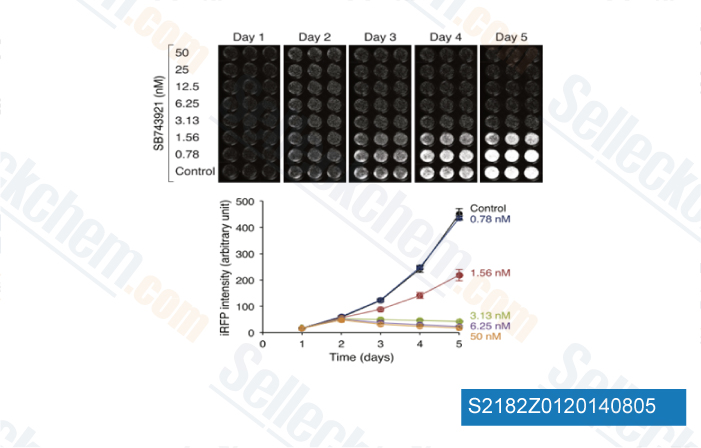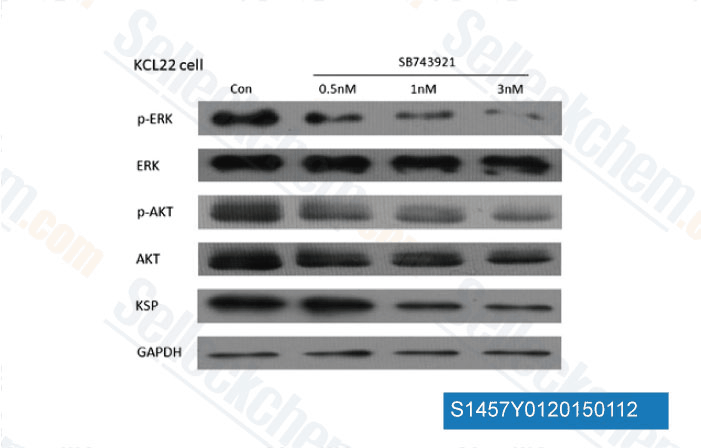|
Toll Free: (877) 796-6397 -- USA and Canada only -- |
Fax: +1-832-582-8590 Orders: +1-832-582-8158 |
Tech Support: +1-832-582-8158 Ext:3 Please provide your Order Number in the email. |
Technical Data
| Formula | C31H33N2O3.HCl |
||||||
| Molecular Weight | 553.52 | CAS No. | 940929-33-9 | ||||
| Solubility (25°C)* | In vitro | DMSO | 100 mg/mL (180.66 mM) | ||||
| Ethanol | 100 mg/mL (180.66 mM) | ||||||
| Water | 46 mg/mL (83.1 mM) | ||||||
| In vivo (Add solvents to the product individually and in order) |
|
||||||
|
* <1 mg/ml means slightly soluble or insoluble. * Please note that Selleck tests the solubility of all compounds in-house, and the actual solubility may differ slightly from published values. This is normal and is due to slight batch-to-batch variations. * Room temperature shipping (Stability testing shows this product can be shipped without any cooling measures.) |
|||||||
Preparing Stock Solutions
Biological Activity
| Description | SB743921 is a kinesin spindle protein (KSP) inhibitor with Ki of 0.1 nM, almost no affinity to MKLP1, Kin2, Kif1A, Kif15, KHC, Kif4 and CENP-E. Phase 1/2. | |||||||||||
|---|---|---|---|---|---|---|---|---|---|---|---|---|
| Targets |
|
|||||||||||
| In vitro | The Ki of SB 743921 for human and mouse KSP is 0.1 nM and 0.12 nM, respectively, while the Ki of SB 743921 for other kinesins including MKLP1, Kin2 is more than 70 μM. SB 743921 blocks assembly of a functional mitotic spindle, thereby causing cell cycle arrest in mitosis and subsequent cell death. SB-743921 has improved potency over ispinesib in both biochemical and cellular assays. [1] | |||||||||||
| In vivo | SB-743921 is greater efficacy in vivo against P388 leukemia. SB-743921 has significant efficacy in a broad spectrum of tumor models differing from that of taxanes. SB-743921 is shown to have activity against advanced human tumor xenografts Colo205 (complete regressions), MCF-7, SK-MES, H69, OVCAR-3 (complete and partial regressions), and HT-29, MX-1, MDA-MB-231, A2780 (tumor growth delay). SB-743921 doesn't cause the neuropathy often associated with the tubulin agents. [1] |
Protocol (from reference)
| Kinase Assay:[2] |
|
|---|---|
| Cell Assay:[2] |
|
| Animal Study:[1] |
|
References
|
Customer Product Validation

-
Data from [ Mol Oncol , 2014 , 8(8):1404-18 ]

-
Data from [ Leuk Lymphoma , 2014 , 1-8 ]
Selleck's SB743921 HCl Has Been Cited by 24 Publications
| Small Cell Lung Carcinoma Cells Depend on KIF11 for Survival [ Int J Mol Sci, 2024, 25(13)7230] | PubMed: 39000337 |
| Kinesins regulate the heterogeneity in centrosome clustering after whole-genome duplication [ Life Sci Alliance, 2024, 7(10)e202402670] | PubMed: 39074902 |
| Dual inhibition of KIF11 and BCL2L1 induces apoptosis in lung adenocarcinoma cells [ Biochem Biophys Res Commun, 2023, 678:84-89] | PubMed: 37619315 |
| Poziotinib for EGFR exon 20-mutant NSCLC: Clinical efficacy, resistance mechanisms, and impact of insertion location on drug sensitivity [ Cancer Cell, 2022, 40(7):754-767.e6] | PubMed: 35820397 |
| The therapeutic effect of KSP inhibitors in preclinical models of cholangiocarcinoma [ Cell Death Dis, 2022, 13-9:799] | PubMed: 36123339 |
| Kinesin spindle protein inhibitor exacerbates cisplatin-induced hair cell damage [ Arch Biochem Biophys, 2022, 731:109432] | PubMed: 36273620 |
| The Global Phosphorylation Landscape of SARS-CoV-2 Infection [ Cell, 2020, 182(3):685-712.e19] | PubMed: 32645325 |
| The Global Phosphorylation Landscape of SARS-CoV-2 Infection [ Cell, 2020, 182(3):685-712.e19] | PubMed: 32645325 |
| Therapeutic targeting of KSP in preclinical models of high-risk neuroblastoma [ Sci Transl Med, 2020, 12(562)eaba4434] | PubMed: 32967973 |
| Mitochondria Redistribution in Enterovirus A71 Infected Cells and Its Effect on Virus Replication [ Virol Sin, 2019, 34(4):397-411] | PubMed: 31069716 |
RETURN POLICY
Selleck Chemical’s Unconditional Return Policy ensures a smooth online shopping experience for our customers. If you are in any way unsatisfied with your purchase, you may return any item(s) within 7 days of receiving it. In the event of product quality issues, either protocol related or product related problems, you may return any item(s) within 365 days from the original purchase date. Please follow the instructions below when returning products.
SHIPPING AND STORAGE
Selleck products are transported at room temperature. If you receive the product at room temperature, please rest assured, the Selleck Quality Inspection Department has conducted experiments to verify that the normal temperature placement of one month will not affect the biological activity of powder products. After collecting, please store the product according to the requirements described in the datasheet. Most Selleck products are stable under the recommended conditions.
NOT FOR HUMAN, VETERINARY DIAGNOSTIC OR THERAPEUTIC USE.
